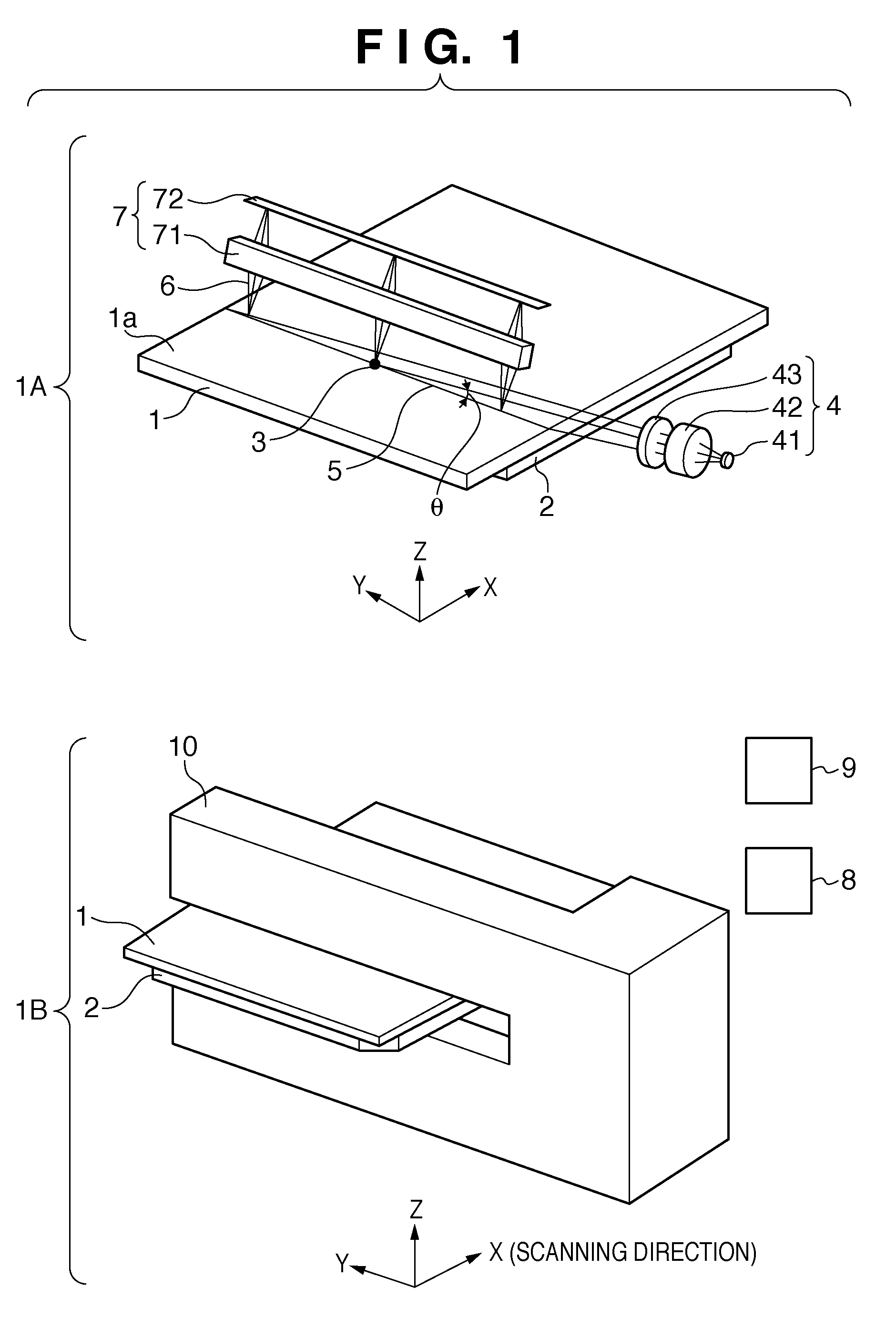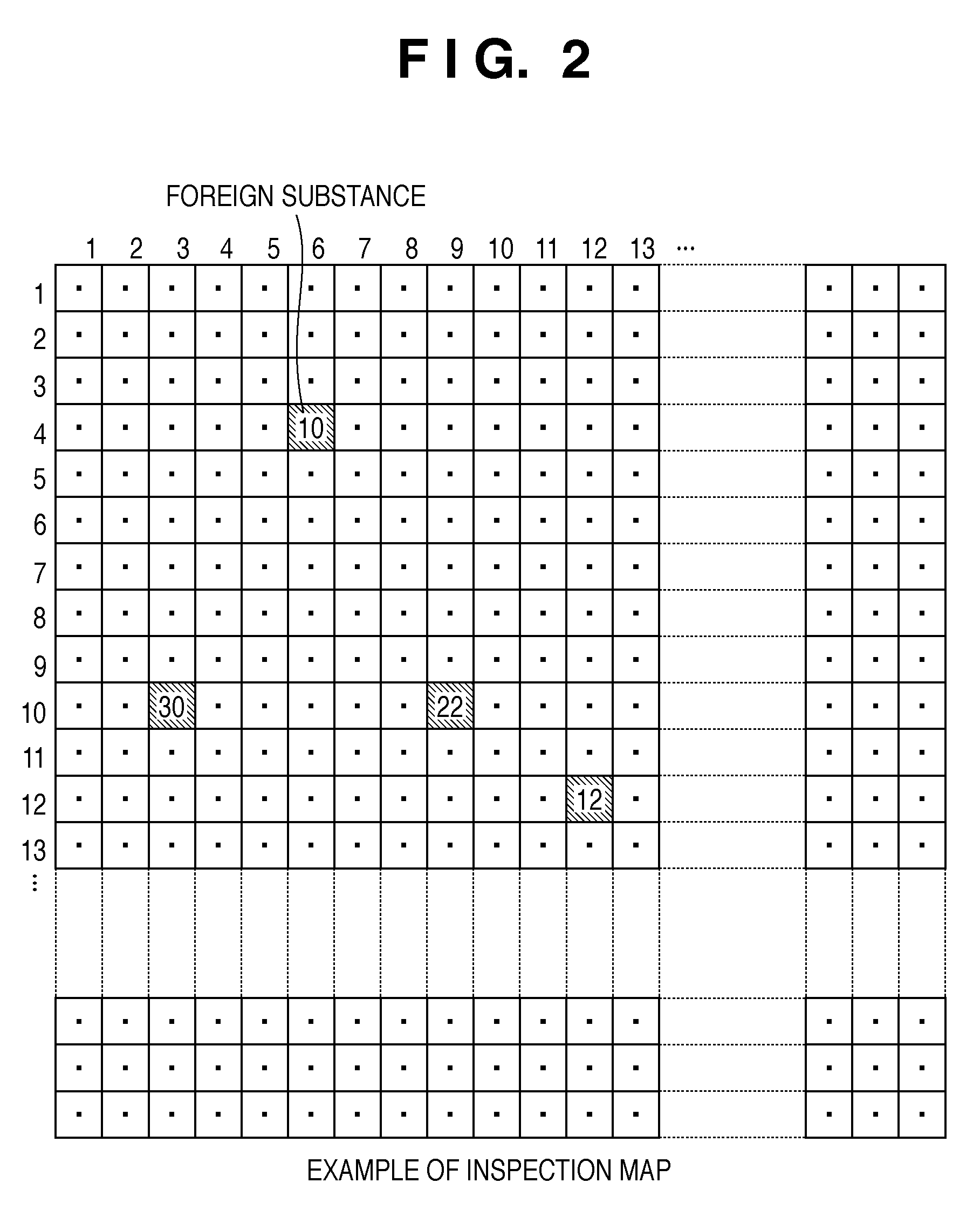Foreign substance inspection apparatus, exposure apparatus, and method of manufacturing device
a technology of exposure apparatus and foreign substance, applied in the direction of instruments, originals for photomechanical treatment, material analysis by optical means, etc., can solve the problems of reducing the lowering the manufacturing yield of the device, and unable to obtain the exact particle size of the foreign substan
- Summary
- Abstract
- Description
- Claims
- Application Information
AI Technical Summary
Benefits of technology
Problems solved by technology
Method used
Image
Examples
first embodiment
[0023]A method of determining the particle size of a foreign substance by an inspection apparatus will be described with reference to 4A to 4D in FIGS. 4 and 5. 4A and 4B in FIG. 4 illustrate an example of the regions where foreign substances are detected by inspection, and conversion curves. The relationship between the intensity of scattered light detected by a line sensor 72 and the particle size of a foreign substance differs depending on the two-dimensional coordinate position on an inspection surface. In the first embodiment, the inspection surface is divided into four regions: regions 81 to 84, and a processing unit 8 of the inspection apparatus holds a plurality of conversion curves 91 to 94 corresponding to the plurality of regions 81 to 84, respectively. 4C and 4D in FIG. 4 are views for explaining a method of calculating the particle size of a foreign substance by selecting a conversion curve in the region to which the two-dimensional coordinate position of the detected f...
second embodiment
[0026]The second embodiment will be described with reference to FIGS. 5 and 6A to 6C in FIG. 6. In the second embodiment, the inspection surface is divided into, for example, 16 regions, as shown in 6A in FIG. 6. A processing unit 8 of an inspection apparatus stores conversion curves 95, 96, 97, and 98 corresponding to four regions 85, 86, 87, and 88, respectively, as shown in 6B in FIG. 6. However, the processing unit 8 holds no conversion curves in regions other than the four regions 85 to 88. In step S1, the inspection apparatus inspects the inspection surface for foreign substances. In step S2, a detector 7 obtains the positions of the foreign substances adhering on the inspection surface, and their detection voltages. In step S3, the processing unit 8 of the inspection apparatus selects or calculates conversion curves used to determine the particle sizes of the foreign substances. The processing unit 8 selects the conversion curves 95 to 98 corresponding to the regions 85 to 88...
third embodiment
[0030]An embodiment in which conversion curves are generated will be described with reference to FIGS. 7 and 8A to 8C in FIG. 8. FIG. 7 illustrates an example of the sequence of a process of generating conversion curves by an inspection apparatus. 8A to 8C in FIG. 8 illustrate an example of foreign substance information and conversion curves referred to in an explanation of the process sequence. The inspection apparatus sets a coordinate position for each 1×1-mm grid defined on the inspection surface, as shown in the inspection map of FIG. 2. Although a coordinate position is set for each 1×1-mm grid in the third embodiment, the grid size can be changed in accordance with the number of division of the area of the inspection region. The inspection apparatus holds a storage area for grid-specific conversion curves. In step S11, a test reticle is loaded into the inspection apparatus. The test reticle is coated with foreign substances with specific particle sizes at specific coordinate ...
PUM
| Property | Measurement | Unit |
|---|---|---|
| sizes | aaaaa | aaaaa |
| sizes | aaaaa | aaaaa |
| sizes | aaaaa | aaaaa |
Abstract
Description
Claims
Application Information
 Login to View More
Login to View More - R&D Engineer
- R&D Manager
- IP Professional
- Industry Leading Data Capabilities
- Powerful AI technology
- Patent DNA Extraction
Browse by: Latest US Patents, China's latest patents, Technical Efficacy Thesaurus, Application Domain, Technology Topic, Popular Technical Reports.
© 2024 PatSnap. All rights reserved.Legal|Privacy policy|Modern Slavery Act Transparency Statement|Sitemap|About US| Contact US: help@patsnap.com










